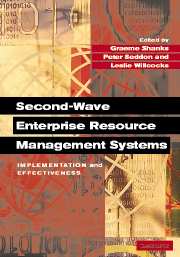Book contents
- Frontmatter
- Contents
- List of Contributors
- Introduction: ERP – The Quiet Revolution?
- Part I Implementation and Effectiveness: Overview
- Part II From Risks to Critical Success Factors
- Part III From Learning to Knowledge
- 10 Implementing Enterprise Resource Planning Systems: The Role of Learning from Failure
- 11 ERP Projects: Good or Bad for SMEs?
- 12 The Role of the CIO and IT Functions in ERP
- 13 Enterprise System Management with Reference Process Models
- 14 An ERP Implementation Case Study from a Knowledge Transfer Perspective
- 15 Knowledge Integration Processes within the Context of Enterprise Resource Planning System Implementation
- Part IV Cultural Aspects of Enterprise Systems
- Part V Future Directions
- Index
- References
13 - Enterprise System Management with Reference Process Models
from Part III - From Learning to Knowledge
Published online by Cambridge University Press: 05 February 2012
- Frontmatter
- Contents
- List of Contributors
- Introduction: ERP – The Quiet Revolution?
- Part I Implementation and Effectiveness: Overview
- Part II From Risks to Critical Success Factors
- Part III From Learning to Knowledge
- 10 Implementing Enterprise Resource Planning Systems: The Role of Learning from Failure
- 11 ERP Projects: Good or Bad for SMEs?
- 12 The Role of the CIO and IT Functions in ERP
- 13 Enterprise System Management with Reference Process Models
- 14 An ERP Implementation Case Study from a Knowledge Transfer Perspective
- 15 Knowledge Integration Processes within the Context of Enterprise Resource Planning System Implementation
- Part IV Cultural Aspects of Enterprise Systems
- Part V Future Directions
- Index
- References
Summary
Introduction
Enterprise Systems (ES) offer configurable business solutions for typical functional areas, such as procurement, materials management, production, sales and distribution, financial accounting, and human resource management (Rosemann, 1999). These functions are typically individualized for industries, such as automobile, retailing, high-tech, etc. Consequently, ES tend to be very comprehensive and complex. This is mirrored in the software documentation, which was often measured in metres before online documentation was developed. To improve the understandability and to stress the process-oriented nature of their solutions, ES vendors have developed reference models which describe the functionality and structure of their systems. Enterprise system reference models exist in the form of function, data, system organization, object and business process models, although the latter is by far the most popular type. The dominance of reference process models results from the increasing popularity of process-oriented management concepts such as business process engineering (Hammer and Champy, 1993) or process innovation (Davenport, 1993), which led to the development of several new process modelling approaches (for example, Kim, 1995).
Enterprise system reference process models describe on different levels of abstraction selected ES processes, that is, sequences of functions supported by the system. Depending on the underlying methodology, these models include details about the control flow (including AND/OR splits or joins), the involved system organizational units, input and output data and business objects (Curran and Keller, 1998).
Information
- Type
- Chapter
- Information
- Second-Wave Enterprise Resource Planning SystemsImplementing for Effectiveness, pp. 315 - 334Publisher: Cambridge University PressPrint publication year: 2003
References
Accessibility standard: Unknown
Why this information is here
This section outlines the accessibility features of this content - including support for screen readers, full keyboard navigation and high-contrast display options. This may not be relevant for you.Accessibility Information
- 2
- Cited by
